Create a free profile to get unlimited access to exclusive videos, sweepstakes, and more!
What do you get when a white dwarf eats a brown dwarf? A very, very energetic cosmic belch.

In the year 1670, astronomers noticed a “new star” in a part of the sky that would later be known as the constellation Vulpecula (the fox). This is a region rich with stars, but few are very bright. This new star, though, grew in brightness until it reached a magnitude of about 3 (a little bit fainter than the stars in the Big Dipper), then faded away.
These types of events are called novae (literally, “new stars”) and are common events in the galaxy. One usually gets bright enough to see with the naked eye every few years or so — though getting this bright is rarer. And this one — later called Nova Vulpeculae, or CK Vulpeculae — didn’t act like a regular nova. It got bright, then faded a little, then got bright again before fading away for real. And modern observations show even more oddities (which I’ll get into shortly).
So it’s clear that something peculiar happened here. But what?
It turns out this wasn’t your usual explodey-type nova. New observations of the site of the 1670 event taken using wonderful ALMA (the Atacama Large Millimeter/Submillimeter Array) telescope have yielded high-resolution images of the what was left over after the nova, tracing the warm dusty material around it, and it’s so odd the astronomers have come up with a pretty wild explanation for what happened.
It looks like a brown dwarf got too close to a white dwarf and was torn apart. Ripped to shreds. And then what was left over exploded.
Here’s what this ridiculous event looks like now, four centuries later:
So yeah, wow. At its peak this thing was emitting energy at a rate 25,000 times higher than the Sun! Good thing it’s over 2,000 light years away. Yikes.
Here’s the deal. First, a white dwarf is a small and extremely dense ball of matter left over when a star like the Sun dies. The exact process is pretty complicated (I devote an entire chapter of my book Death From the Skies! to it, in fact), but in a nutshell the star runs out of fuel in its core, swells up to become a red giant, and blows off its outer layers. After a while, all that’s left is the core of the star, which has about half the mass of the Sun or so compressed into a ball the size of the Earth. It’s very hot and very small, so we call it a white dwarf.
The gravity near a white dwarf is terrifying. It can have a surface gravity hundreds of thousands of times Earth’s — if I stood on a white dwarf, I’d weigh as much as 30 Statues of Liberty! So I wouldn’t be standing, actually. I’d be a very thin smear of highly ionized plasma.
If a “normal” star like the Sun is orbiting a white dwarf, the gravity from the dwarf can be so strong it can siphon material off that star. This material piles up on the white dwarf, and if conditions are just right, it gets so highly compressed and so hot it undergoes sudden and catastrophic thermonuclear fusion. The resulting explosion is huge, lighting up the skies with as much energy as 100,000 times the Sun!
That’s what we call a classical nova.
But Nova Vulpeculae didn’t act like this. It didn’t get bright enough, for one thing (a classical nova would’ve gotten at least 5 times brighter, if not more). It peaked in brightness twice, when you’d expect it to just get bright once and fade. And the debris we see flying away from the site of the explosion is too small. After nearly 400 years, the size of the structure left over should be far larger, meaning we’re seeing a much smaller velocity to the expanding gas.
It turns out there are other cosmic events that can do things like this. Two normal stars can merge, for example, or an evolved star (like a red giant mentioned above) can eat a planet. But none of these events fully explain the 1670 event either. We know there’s a hot, faint object in the middle blasting out ultraviolet light, which is what you expect from a white dwarf, so it couldn’t have been two normal stars merging. And no star was seen in this position before 1670, ruling out a bright red giant.
And then there are other weirdnesses. Earlier observations detected lithium in the expanding debris. That’s very peculiar indeed: Most stars don’t have any lithium in them. As nuclear fuel goes lithium is very fragile and easily fused, so stars run out of it very quickly after they’re born.
But lithium is abundant in brown dwarfs. Hmmmm.
A brown dwarf is an object more massive than a planet, but not quite massive enough to initiate nuclear fusion in its core. That fusion is what makes a star a star, supplying energy to the outer layers and making it shine. But it takes a lot of mass to squeeze atoms in the core hard enough to get them to fuse: You need an object with roughly 1% the mass of the Sun to do that, or about 80 times the mass of Jupiter*.
Brown dwarfs are common, even though they were only first seen in the 1990s. Since they don’t shine like stars, they’re very faint and hard to detect. Some do orbit stars like the Sun, and that allows us to make a picture about what happened with Nova Vulpeculae.
Once upon a time, a Sun-like star and a brown dwarf orbited each other. The star aged and died, blew away its outer layers, and became a white dwarf. The brown dwarf was in a close orbit — for a time it may have even been inside the envelope of its red giant companion! This caused its orbit to drop in closer.
At some point it got too close. The immense gravity of the white dwarf started pulling material off of it. This formed a disk, called an accretion disk, around the white dwarf. This disk of stripped brown dwarf material is pretty hot, and close to the center gets so hot it starts to blow off, expanding away from the white dwarf. We see this now as a faint halo around the system (with the lithium in it from the brown dwarf). It’s shaped like an hourglass, the wind blowing up and down from the disk.
The brown dwarf got so close that tides from the white dwarf drew off more material. The matter fell onto the tiny star, a much thicker stream than before. The wind became more like a jet, a beam of matter blowing away, thick with dust and other more complex molecules.
Then, catastrophe. The core of the brown dwarf fell in, was torn apart by the fierce tides, and erupted with light. This complicated process isn’t as bright as a classical nova, but still pretty impressively terrifying, and explains most of what’s been seen both from the nova event itself and the weird structure surrounding it today.
Such a thing may not be terribly common in the galaxy, or else we’d see more of them. But it does happen, and if you keep your eyes open long enough and search hard enough, even rare events can be seen. It’s a big, big galaxy. Weird stuff happens.
*The lower limit to a brown dwarf is more complicated, and involves the core of the object getting condensed enough to form a weird state of mater called degeneracy. That happens at about 13 times Jupiter’s mass. So a brown dwarf is in general between 13 and 80 Jupiter masses.





























